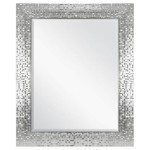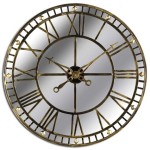Venetian Glass Mirrors in the Bathroom
Venetian glass mirrors offer a unique blend of artistry and functionality, making them a sought-after addition to bathroom spaces. Their reflective qualities combined with intricate designs can transform a utilitarian room into a luxurious retreat. Understanding the history, craftsmanship, and design considerations involved can aid in selecting the perfect Venetian glass mirror for a bathroom environment.
The origins of Venetian glassmaking can be traced back to the Roman Empire. However, it was during the late Middle Ages and Renaissance that Venice emerged as a prominent center for glass production. Murano, an island in the Venetian lagoon, became the hub of this burgeoning industry. Glassmakers developed innovative techniques, including glassblowing and the creation of cristallo, a remarkably clear and colorless glass. These advancements paved the way for the production of exquisite mirrors that quickly gained popularity among European nobility.
Creating a Venetian glass mirror is a labor-intensive process requiring significant skill and precision. Artisans employ traditional techniques passed down through generations. One such method is the application of thin layers of silver or other reflective metals to the back of the glass. This process creates the mirror's reflective surface. Many Venetian mirrors also feature decorative elements. These can include intricate etchings, elaborate glass overlays, and the application of colorful glass tesserae, reminiscent of Venetian mosaics.
The unique characteristics of Venetian glass contribute to the distinctive appeal of these mirrors. The glass itself often possesses a slight irregularity and texture, a result of traditional hand-blown techniques. This subtle imperfection adds to the mirror's character and charm. Furthermore, Venetian glass mirrors may exhibit a slight tint, often a soft green or blue, due to the chemical composition of the glass. This subtle coloration can enhance the overall aesthetic and create a warmer, more inviting ambiance.
When incorporating Venetian glass mirrors into a bathroom, several design considerations should be explored. The size and shape of the mirror must be carefully chosen to complement the dimensions and style of the bathroom. A large, ornately framed Venetian mirror can serve as a focal point in a spacious bathroom, while smaller, more simply designed mirrors may be more appropriate for smaller spaces or powder rooms. The mirror's frame, often crafted from wood, metal, or even Murano glass itself, plays a crucial role in the overall aesthetic. The frame should complement the mirror's design and harmonize with the bathroom’s existing décor.
The placement of a Venetian glass mirror within the bathroom is equally critical. Functionality dictates that the mirror be positioned conveniently for daily use, primarily above the vanity. However, the mirror can also be used to enhance the overall design of the bathroom. Strategically positioning the mirror to reflect natural light from a window can brighten the space and create an illusion of greater size. Additionally, placing a Venetian glass mirror opposite a decorative element can amplify its visual impact and add depth to the room.
Maintaining the beauty and integrity of a Venetian glass mirror requires proper care. Regular cleaning with a soft, damp cloth and a mild glass cleaner is recommended. Abrasive cleaners or harsh chemicals should be avoided as they can damage the delicate surface of the glass and the intricate detailing. Furthermore, excessive humidity can affect the mirror's reflective backing, potentially leading to discoloration or deterioration over time. Ensuring proper ventilation in the bathroom is crucial for preserving the longevity of a Venetian glass mirror.
Beyond their functional purpose, Venetian glass mirrors serve as decorative statements. They can introduce an element of elegance, artistry, and historical significance to a bathroom space. Their reflective qualities enhance the perception of light and space, while their intricate designs add a touch of opulence. The variety of styles available allows for seamless integration into diverse design schemes, from classic and traditional to contemporary and eclectic. Whether chosen as a focal point or a subtle accent, a Venetian glass mirror offers a unique opportunity to elevate the aesthetic of a bathroom environment.
The investment in a Venetian glass mirror represents more than just a purchase; it represents an acquisition of a piece of art. The skilled craftsmanship, the rich history, and the unique characteristics of Venetian glass make these mirrors valuable additions to any home. Their presence in a bathroom transcends mere functionality, transforming the space into a haven of beauty and refinement. By carefully considering the various design elements and maintenance requirements, one can ensure that a Venetian glass mirror enhances the bathroom’s aesthetic for years to come.

30 Images Of Beautiful Interior Inspiration For The Last July Days Tig Digital Publication Interiors Feminine Bathroom

6 Astounding Venetian Mirror Ideas To Inspire You Large Bathroom Mirrors Wall

Gray Dual Bath Vanity With Venetian Mirrors Transitional Bathroom

Arched Bathroom Alcove With French Washstand And Venetian Mirror Layered Over Antiqued Interior Design

Spotted Venetian Style Mirrors

Venetian Mirrors The Berkshire House

Oval Venetian Mirror Over Washstand With Glass Legs Transitional Bathroom

17 Best Venetian Mirrors Bathroom Inspiration Beautiful Bathrooms Design

Venetian Mirrors The Berkshire House

Most Amazing Venetian Mirrors For Your Bathroom








